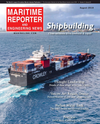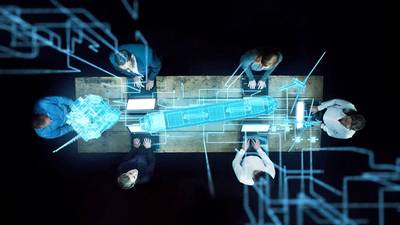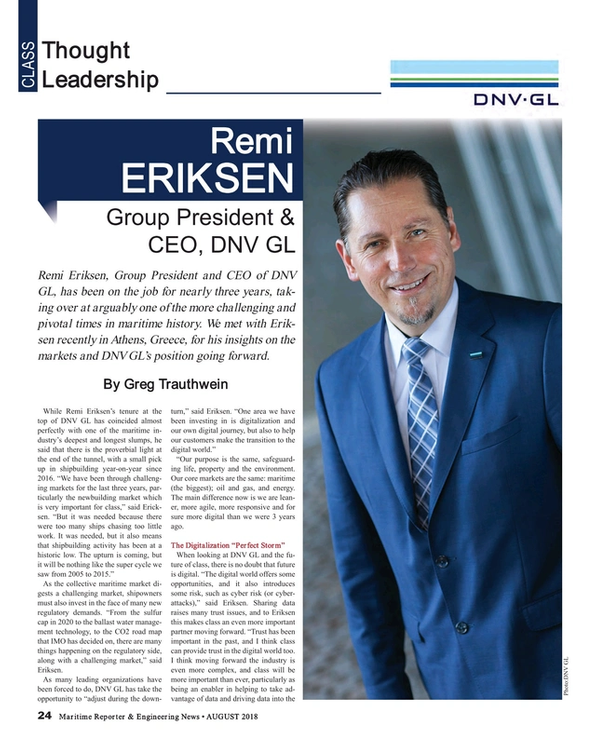
Maritime Thought Leadership: Remi Eriksen, DNV GL
Remi Eriksen, Group President and CEO of DNV GL, has been on the job for nearly three years, taking over at arguably one of the more challenging and pivotal times in maritime history. We met with Eriksen recently in Athens, Greece, for his insights on the markets and DNV GL’s position going forward.
While Remi Eriksen’s tenure at the top of DNV GL has coincided almost perfectly with one of the maritime industry’s deepest and longest slumps, he said that there is the proverbial light at the end of the tunnel, with a small pick up in shipbuilding year-on-year since 2016. “We have been through challenging markets for the last three years, particularly the newbuilding market which is very important for class,” said Ericksen. “But it was needed because there were too many ships chasing too little work. It was needed, but it also means that shipbuilding activity has been at a historic low. The upturn is coming, but it will be nothing like the super cycle we saw from 2005 to 2015.
As the collective maritime market digests a challenging market, shipowners must also invest in the face of many new regulatory demands. “From the sulfur cap in 2020 to the ballast water management technology, to the CO2 road map that IMO has decided on, there are many things happening on the regulatory side, along with a challenging market,” said Eriksen.
As many leading organizations have been forced to do, DNV GL has take the opportunity to “adjust during the downturn,” said Eriksen. “One area we have been investing in is digitalization and our own digital journey, but also to help our customers make the transition to the digital world.”
“Our purpose is the same, safeguarding life, property and the environment. Our core markets are the same: maritime (the biggest); oil and gas, and energy. The main difference now is we are leaner, more agile, more responsive and for sure more digital than we were three years ago.
The Digitalization “Perfect Storm”
When looking at DNV GL and the future of class, there is no doubt that future is digital. “The digital world offers some opportunities, and it also introduces some risk, such as cyber risk (or cyber-attacks),” said Eriksen. Sharing data raises many trust issues, and to Eriksen this makes class an even more important partner moving forward. “Trust has been important in the past, and I think class can provide trust in the digital world too. I think moving forward the industry is even more complex, and class will be more important than ever, particularly as being an enabler in helping to take advantage of data and driving data into the decision-making process.”
While DNV GL talks a good digital game, it backs the talk with action, as near 60% of DNV GL’s Research & Development today is spent on digitalization. “The speed of change (in the digital world) is exponential. Just looking at ourselves, we are much more agile and efficient,” he said. In fact, he notes four factors that have created a digitalization ‘perfect storm.’
- Sensor technology
- Connectivity
- Computing Power
- Algorithms and Methods on top of it all to take advantage of all of the data
“If you look at the methods that have been present in academia since I went to school in the 1980s, we talked about neural networks, we talked about artificial intelligence and machine learning, but we didn’t have the sensor part, we didn’t have the connectivity part, we didn’t have the computing power and the storage,” said Eriksen. “Now we have high capacity at good prices, creating this ‘perfect storm’ … the methods have been there for quite some time, so now we can actually put them to good use in real life, and that is helping to cause the speed of change.”
While ‘speed of change’ and ‘maritime’ can sometimes be an oxymoron, the digital trend in maritime is real and manifesting itself in many ways. Looking at it through the DNV GL lens, “a lot of this goes into sensor and control systems, and this will be relevant for all types of shipping,” said Eriksen.
 “We are now introducing an Open Simulation Platform where different players, different equipment suppliers can simulate the interaction between different pieces of equipment, you can actually ‘test’ the interaction and the interfaces before you start building. We’re now running a joint industry project (JIP) … we have the technology to enable the open simulation platform, but now we need to engage the different players in the right way to start using the platform. It is in the early phase, but should be ready in a year or so.”“This can help elevate situational awareness and ultimately autonomous shipping. Sensor and sensor fusion is one end, decision making is another.” One project worth watching is the Yara Birkland, which will be operational in 2019. “The remote ops will be the first step, then you need to have the correct sensor and sensor fusion so that you have the correct situational understanding – so you know what’s going on. The other part is on the decision making, the logic.” The next step is not doing the decision making remotely, rather on the vessels by computers, “A lot of research is going into that,” Eriksen said.A cornerstone of the DNV GL digitalization path its Veracity platform, an open industry, secure platform for digital innovation and industry collaboration. The platform includes a marketplace where users can access all DNV GL's digital services and applications, as well as services from third parties. Veracity also includes a community for developers to make it easier to develop new applications and analytics. Finally, the platform facilitates secure and easy data management and data sharing.
“We are now introducing an Open Simulation Platform where different players, different equipment suppliers can simulate the interaction between different pieces of equipment, you can actually ‘test’ the interaction and the interfaces before you start building. We’re now running a joint industry project (JIP) … we have the technology to enable the open simulation platform, but now we need to engage the different players in the right way to start using the platform. It is in the early phase, but should be ready in a year or so.”“This can help elevate situational awareness and ultimately autonomous shipping. Sensor and sensor fusion is one end, decision making is another.” One project worth watching is the Yara Birkland, which will be operational in 2019. “The remote ops will be the first step, then you need to have the correct sensor and sensor fusion so that you have the correct situational understanding – so you know what’s going on. The other part is on the decision making, the logic.” The next step is not doing the decision making remotely, rather on the vessels by computers, “A lot of research is going into that,” Eriksen said.A cornerstone of the DNV GL digitalization path its Veracity platform, an open industry, secure platform for digital innovation and industry collaboration. The platform includes a marketplace where users can access all DNV GL's digital services and applications, as well as services from third parties. Veracity also includes a community for developers to make it easier to develop new applications and analytics. Finally, the platform facilitates secure and easy data management and data sharing.
“It (Veracity) is gaining traction, today with almost 130,000 users representing 1,500 companies, with close to 1 million service subscriptions meaning each user is subscribing to more than seven services in average. We have seen this scaling up rapidly,” said Eriksen.
Digitalization and cyber security go hand-in-hand, and to this end DNV GL recently was the first to offer a new cyber secure notation. “Cyber Security is on everyone’s mind right now and (the creation of the new “Cyber secure” notation) is partly a push by us, and partly a pull by our customers,” said Eriksen. “We are doing a lot internally, both with our own people and with partnerships with the likes of Microsoft, leveraging the security developments they are building into their products and services. We have a good set up there, to take the best of their research and technology and add to this our own systems around it. A very competent IT organization and external partnerships are key to good cyber security, but this is a very fast developing market, and it’s something that you must always stay on top of and think ahead.”
DNV GL takes the Cyber Security issue a step further, offering ‘ethical hacking’ as a service, both internally and to its clients, to expose weaknesses. “That is the paranoia that you need to have all of the time. Nothing is 100% secure.”
$3.1 Trillion per Year: When Big Data is Bad Data
While much of the focus today is on data – the collection, dissemination and efficient deployment of data – not much has been reported on the cost of Bad Data. Remi Eriksen, Group President & CEO of DNV GL, put the matter in perspective during a presentation in Athens, Greece, during Posidonia. Eriksen, citing estimates from IBM, said that in 2016, in the U.S. alone, $3.1 trillion* was IBM’s estimate of the yearly cost of poor quality data, a stunning figure, particularly when you consider that research firm IDC estimates that the size of the big data market globally in 2016 was a mere (by comparison) $136 billion.
*(Source: Bad Data Costs the U.S. $3 Trillion Per Year, by Thomas C. Redman, Harvard Business Review; https://hbr.org/2016/09/bad-data-costs-the-u-s-3-trillion-per-year)
Read Maritime Thought Leadership: Remi Eriksen, DNV GL in Pdf, Flash or Html5 edition of August 2018 Maritime Reporter
Other stories from August 2018 issue
Content
- BIG LIFT: The Importance of the JH143 Builder’s Risk Surveys page: 12
- ShipSure 2.0: Big Data, Bigger Benefits page: 16
- Maritime Thought Leadership: Christopher J. Wiernicki, ABS page: 18
- Maritime Thought Leadership: Remi Eriksen, DNV GL page: 24
- Maritime Thought Leadership: Koichi Fujiwara, ClassNK page: 28
- Thought Leadership: Matthieu de Tugny, COO, Bureau Veritas page: 30
- Shipbuilding: “We had shipyard for dinner …” page: 34
- Shipbuilding: Oman Drydock CEO Aims to Triple Revenue by 2021 page: 40
- Shipbuilder in Focus: DAMEN page: 42
- Shipyard Focus: Vigor page: 48
- Shipbuilding in Sweden: Oresund Dry Docks page: 49
- Cruise Ship Refit: Business Steady at Blohm + Voss page: 51
- Ship Repair: N-KOM Repair Volume Up 25% page: 52
- Shipyard in Focus: Spanopoulos Group - Yacht Repairing and Shipbuilding page: 54
- Shipbuilding in Spain: Astican & Astander page: 57
- Shipyard in Focus: Conrad Shipyard page: 57
- Shipbuilding: Seaspan Shipyards & Building Canada’s Future page: 58
- Finland: A Hot-Bed of ICEBREAKER Technology page: 62
- KVH & Intelsat: On the Digitization Fast Track page: 68
- Shipping Executive Focus: Art Regan, Executive Chairman, Genco Shipping & Trading page: 70
- SMM Interview: Three Questions for Claus Ulrich Selbach page: 98


